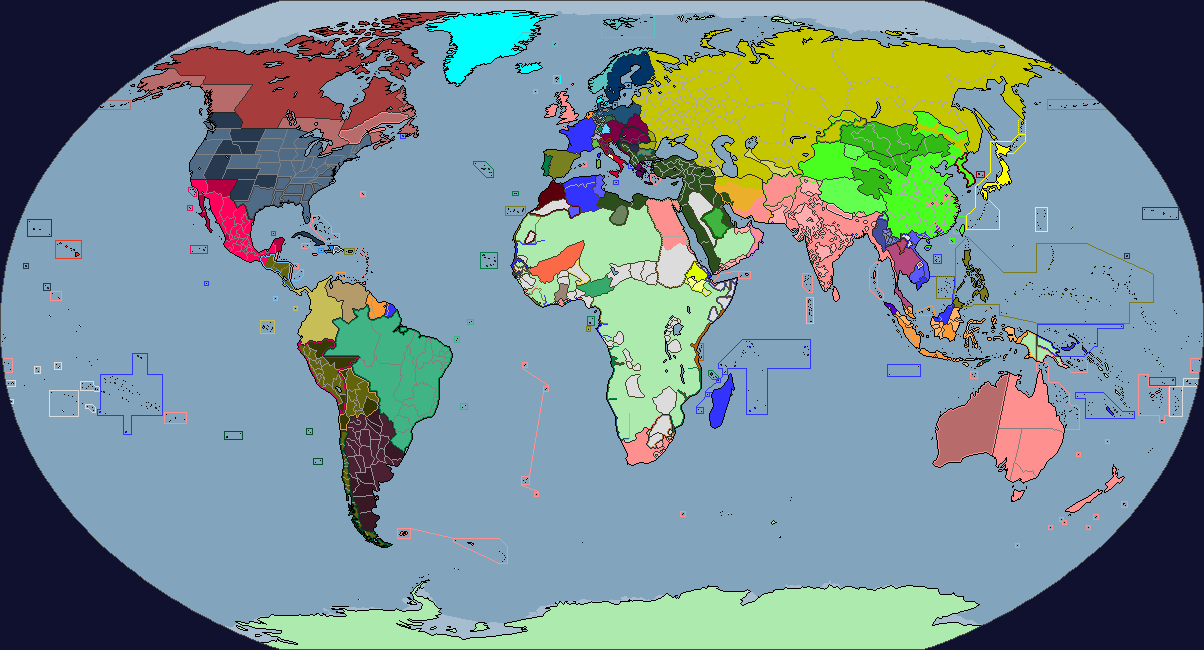And just when it seemed like this world had some potential to thrive... it stumbles. That must be a tough pill to swallow for Russia & Co.
Yeah, but it was in a way only a matter of time. Russia lacks the power projection of the OTL USA (somewhat fewer people, still less industry, etc.), which means other powers can get up to mischief and some efforts at a global coalition were built on shaky foundations.
I see that Mexico has joined the Latin American Union (that is what it was called, right?) Was the decision to let them in related to the nuclear strikes? How has a powerful member in both Europe and North America affected Brazil's domination of the Union? Is Argentina cozying up to Mexico or are they rather loyal to Brasilia at this point?
It was more US economic influence (and a bit of political assassination). New Mexico and the Amerindian Homeland folded, but the Mexicans had their pride, and felt Brazil was the lesser evil. Mexico and Argentina actually really don't get along. Argentina was reluctant to join and wants to keep the LAU a very loose free trade organisation (they're still very conservative and nativist). Mexico meanwhile has suffered from a serious recession after the fall of the USSA and has lots of people big on freedom of movement reforms and greater economic cooperation. Brazil like's Mexico's support for greater unity, but remains weary about risking all those Mexicans (and other central Americans from formerly communist nations) flood south into the more prosperous South America.
And wow, those bombs hit MASSIVE population centers! What is the death toll, roughly, from the bombs alone? How much carbon was sent into the atmosphere? I see Cairo has been wiped from the map; does the IC still have any form of cohesive government? Or are we seeing the map the day before they spiral into confused and bloody anarchy?
Pretty big ones, yes. I'd put IC losses at 20-25 million overall, while Red India lost ~15 million (keep in mind this is the day after the exchange, so the radiation zone is pretty big). The IC government had evacuated to positions in the desert just before launching their nukes (a move that once leaked will basically decimate all support, currently state media insists they were evacuated when Indian bombers were sighted). There's going to be about a week or two of inertia before things truly fall apart (lies about the extent of damage, troops in denial, religious zeal ignoring logic, etc.), but things will fall apart quickly.
Poor Turkey... if we thought there was a refugee problem in OTL, it's going to be nothing compared to what's coming. Though it seems like the IC, for most of its history, has been an economically powerful and successful nation. Perhaps things will be stable enough in some places (Tripoli, Tunis, Medina, etc.) for a significant portion of the population to want to stay? In any case, hopefully Russia and Friends can navigate the situation a bit better than the EU has OTL.
Yeah, the IC was doing decent enough, with Iran like living standards for most of it's existance. Having been so far away Tunisia and Libya emerged alright, though that also means the hardliner governments were left in power. They're also a small chunk of overall population. And yes, this refugee crisis will make OTL seen like a cakewalk. Though in this world not everyone is going north. Will northern Egypt so irradiated plenty on the upper Nile will go south instead. Africa might not be super great, but at least it isn't radioactive.
Something just caught my eye... did the Indians bomb Mecca??? That's certainly not going to help their chances of staying together. Where there might have been a marginal difference in enlistment between Buddhists and Muslims before, destroying the most sacred site in Islam is certainly going to change that. Where the IC might just fall into anarchy, it seems there might be a significant chance that the Indians collapse into civil war.
No. It was Jeddah that got nuked. India's government might not like religion, but they weren't about to tick off tens of millions of their own citizens, their one real ally of Indonesia, and Bengal. There was some grumbling about fallout reaching Mecca and Medina, but considering what the hard liners in Cairo were getting up to (Saudi like demolition schemes, but done in a hurry) most approve of breaking IC control in the region.
I see the Americans are hard at work reconnecting with Texas. Do they have similar plans for Deseret, Canada, New Africa?
Yes. Deseret has basically solved the issue by selling a number of through railways, highways, and pipelines, hoping appeasement works. The Canadas are generally more confrontational (like the Baltics OTL), while New Africa is highly indecisive as many wonder if leaving was such a good idea (and there's lots of whites who 'know' it was a bad idea).
Good to see this map series return, bleak as it may be. Keep up the good work!
It's not got too much longer to go, but hopefully things can turn around.
